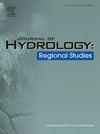Assessment of the sedimentation and trapping efficiency in dam reservoirs by applying the settling basin framework
IF 4.7
2区 地球科学
Q1 WATER RESOURCES
引用次数: 0
Abstract
Study region
The investigated object is the Lobo Dam reservoir, located in the south part of the Lobo River Basin in west-central Côte d’Ivoire, West Africa.
Study focus
Dam reservoirs in tropical climates face rapid siltation and eutrophication challenges, necessitating new analytical solutions to understand their capacity to trap sediment inputs. This study presents a hydrosedimentary mathematical model based on the theory of settling basins and Gamma Law approaches to describe the settling velocity of suspended solids. Using field data from the Lobo River reservoir in Côte d′Ivoire.
New hydrological insights for the region
The analysis shows that the reservoir's trapping capacity is influenced by settling velocity, critical velocity, shape parameter 1/r, and the Peclet number (Pe). The study found strong synchronization between models for constant settling velocity (CV-NT, CV-CM, CV-Teeter (1986)) and variable settling velocity (VV-NT, VV-CM) with Teeter’s (1986) model. This agreement validates the proposed models. However, for Pe > 4, the numerical values and curves fall outside the validity range of Teeter’s (1986) model, particularly during dry periods.
The findings provide crucial insights into the hydrosedimentary dynamics of the Lobo River reservoir, emphasizing the need to account for seasonal variations and hydrological conditions. This research offers valuable guidance for sediment and water resource management, contributing to the sustainability of reservoirs in tropical regions facing similar environmental pressures.
求助全文
约1分钟内获得全文
求助全文
来源期刊

Journal of Hydrology-Regional Studies
Earth and Planetary Sciences-Earth and Planetary Sciences (miscellaneous)
CiteScore
6.70
自引率
8.50%
发文量
284
审稿时长
60 days
期刊介绍:
Journal of Hydrology: Regional Studies publishes original research papers enhancing the science of hydrology and aiming at region-specific problems, past and future conditions, analysis, review and solutions. The journal particularly welcomes research papers that deliver new insights into region-specific hydrological processes and responses to changing conditions, as well as contributions that incorporate interdisciplinarity and translational science.
 求助内容:
求助内容: 应助结果提醒方式:
应助结果提醒方式:


